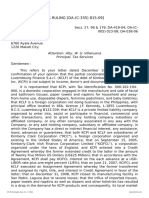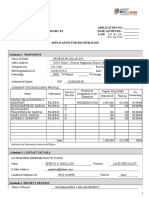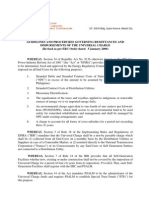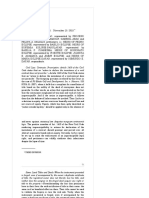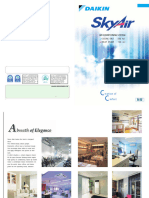4.8. Adjustment of Valve Clearance: DV11 Operation and Maintenance
4.8. Adjustment of Valve Clearance: DV11 Operation and Maintenance
Uploaded by
ООО "СК "СМП-708"Copyright:
Available Formats
4.8. Adjustment of Valve Clearance: DV11 Operation and Maintenance
4.8. Adjustment of Valve Clearance: DV11 Operation and Maintenance
Uploaded by
ООО "СК "СМП-708"Original Title
Copyright
Available Formats
Share this document
Did you find this document useful?
Is this content inappropriate?
Copyright:
Available Formats
4.8. Adjustment of Valve Clearance: DV11 Operation and Maintenance
4.8. Adjustment of Valve Clearance: DV11 Operation and Maintenance
Uploaded by
ООО "СК "СМП-708"Copyright:
Available Formats
DV11
Operation and Maintenance
4.8. Adjustment of valve clearance
4.8.1. General information
The valve clearances are to be adjusted at the times of the following situations.
z When the engine is overhauled and the cylinder heads are disassembled.
z When severe noise comes from valve train.
z When the engine is not normally operated, even though there is no trouble in the
fuel system.
4.8.2. Valve clearance adjust procedure
z After letting the #1 cylinder's piston come at the compression top dead center by
turning the crankshaft, adjust the valve clearances.
z Loosen the lock nuts of rocker arm adjusting screws and push the feeler gauge
of specified value between a rocker arm and a valve stem and adjust the
clearance with adjusting screw respectively and then tighten with the lock nut.
z As for the valve clearance, adjust it when in cold, as follows.
Engine model Intake valve (A) Exhaust valve (B) Engine brake (C)
DV11 0.4 mm 0.5 mm 1.5 mm
Engine brake Adjusting bolt
Engine brake
Valve adjusting bolt Valve adjusting
Rocker arm bolt
Caliper adjusting nut
Caliper adjusting bolt Rocker arm
Valve adjusting nut C
A B
Caliper Push rod Caliper Push rod
Intake valve Exhaust valve spring
spring
Exhaust valve
Intake valve
Valve seat
Valve seat
Intake valve adjusting Exhaust valve, engine brake adjusting
176 Commissioning and Operation
Printed in Mar. 2005 PS-MMA0608-E1A
Downloaded from www.Manualslib.com manuals search engine
DV11
Operation and Maintenance
< Adjust the valve clearance as following order. >
1) Rotating the engine, let #6 cylinder overlap.
2) In time that #1 cylinder become the state of top dead center, adjust the valve
clearance corresponding to ” ◎ “ of following lists.
3) Rotating the crankshaft by 90° rotation, adjust the valve clearance
corresponding to " ◉ ".
4) Rotating the crankshaft by 1 rotation (360° rotation), let #1 cylinder overlap.
5) In time that #5 cylinder become the state of top dead center, adjust the valve
clearance corresponding to ” ● “ of following lists.
6) Rotating the crankshaft by 450° rotation, adjust the valve clearance
corresponding to " ○ ".
7) After rechecking the valve clearance, readjust if necessary.
z No. 1 Cylinder is located at the side where cooling water pump was installed.
Fly wheel Cylinder No Exhaust valve Intake valve Cooling fan
Valve adjusting position Intake valve Exhaust valve
177 Commissioning and Operation
Printed in Mar. 2005 PS-MMA0608-E1A
Downloaded from www.Manualslib.com manuals search engine
DV11
Operation and Maintenance
z Adjusting of valves (Type 1)
Cylinder No 1 2 3 4 5 6
Valve adjusting Exhaust Intake Exhaust Intake Exhaust Intake Intake Exhaust Intake Exhaust Intake Exhaust
#1 cylinder top dead center
◎ ◎ ◎ ◎ ◎
(#5 cylinder valve overlap)
Crankshaft 90° revolution ◉
360° revolution
#5 cylinder top dead center
(#1 cylinder valve overlap)
● ● ● ● ●
Crank shaft
450° revolution ○
z Adjusting of valves (Type 2)
Adjusting of the valve overlapping on each cylinder is done as follow.
When each cylinder is valve overlap
1 4 2 5 3 6
(Explosion cylinder No. order)
Valve adjusting cylinder No. 5 3 6 1 4 2
z Adjusting of engine brake (Adjusting of slave piston)
Cylinder No
Engine brake slave piston adjusting no.
Slave piston adjusting
#1 cylinder top dead center
1 2 4
(#5 cylinder valve overlap)
360° revolution
3 5 6
(#1 cylinder valve overlap)
* When adjust slave piston of the engine brake, adjust only exhaust valve
correspond to the cylinder number.
4.9. Tightening the Cylinder Head Bolts
z Coat the engine oil on the cylinder
head bolt, assemble with specified
torque according to the order of the
assembling.
178 Commissioning and Operation
Printed in Mar. 2005 PS-MMA0608-E1A
Downloaded from www.Manualslib.com manuals search engine
DV11
Operation and Maintenance
< Cylinder head bolts >
Spec
M16×2.0×176
1st : 8kg.m
2nd : 180°
Torque
2rd : 150°
(Angle torque)
< Cylinder head bolt’s Tightening Order >
(1) First step : Coat the bolts with engine oil.
(2) Second step: Screw down 1 ~ 2 threads
(3) Third step : Tighten with about 8 kg.m by wrench
(4) Fourth step : Tighten with about 15kg.m by torque wrench
(5) Fifth step : Tighten with rotating angle method 90°
(6) Sixth step : Tighten with rotating angle method 90°
(7) Seven step : Tighten with final additional rotating angle method 60°
179 Commissioning and Operation
Printed in Mar. 2005 PS-MMA0608-E1A
Downloaded from www.Manualslib.com manuals search engine
DV11
Operation and Maintenance
5. Maintenance of Major Components
5.1. Cooling System
5.1.1. General descriptions and main data
z This engine is water-cooling type. Heat from the combustion chamber and engine
oil heat are cooled down by coolant and radiated to the outside, resulting in the
normal operation of the engine.
z Looking into the cooling system, the water pumped up by the water pump
circulates around the oil cooler through the water pipe to absorb the oil heat, and
then flows through the water jacket of the cylinder block and water passage of the
cylinder head to absorb the heat of the combustion chamber.
Cylinder block Cylinder head
Cylinder no.
Oil cooler
Cylinder block
Thermostat
Water pump
Radiator
z The water absorbing the oil heat and combustion chamber heat goes on to the
thermostat through the water pipe, and circulates to the water pump if water
temperature is lower than the valve opening temperature on the thermostat, while
circulating to the radiator at water temperature higher than the valve opening
temperature. At the radiator, the heat absorbed in the coolant is radiated to cool
down and the coolant recirculates to the water pump.
180 Maintenance of Major Components
Printed in Mar. 2005 PS-MMA0608-E1A
Downloaded from www.Manualslib.com manuals search engine
DV11
Operation and Maintenance
5.1.2. Specification
Item Specification
Type Centrifugal type
Pumping speed 3,500 rpm
1. Water pump
Delivery about 452 liter/min or more
Pumping back pressure Bellow 1.8 bar
Operating temperature 79°C type 83°C type
8mm or more 8mm or more
2. Thermostat Valve lift
(at 94°C) (at 95°C)
Operating temperature 79 ∼ 94°C 83 ∼ 95°C
3. Cooling fan and belt
Fan diameter – Number of blades Truck : φ711.2mm – 9
Fan belt tension Auto tensioner
5.1.3. Thermostat
z General descriptions and main data
The thermostat maintains a
constant temperature of coolant (90
∼ 95 °C) and improves thermal
efficiency of the engine by
preventing heat loss.
Namely, when the temperature of
coolant is low, the thermostat valve
is closed to make the coolant
bypass to directly enter the water
pump; when the coolant
temperature rises to open wide the
thermostat valve, the bypass circuit
is closed and the water passage to
the radiator is opened so that the
coolant is forced to flow into the
radiator.
Item In moderate climates In tropical climates
Type Wax-pallet type
Open at 83 °C 71 °C
Open wide at 95 °C 85 °C
Valve lift 8 mm or more 8 mm or more
181 Maintenance of Major Components
Printed in Mar. 2005 PS-MMA0608-E1A
Downloaded from www.Manualslib.com manuals search engine
DV11
Operation and Maintenance
z Inspecting
(1) Check the wax pallet and
spring for damage.
(2) Put the thermostat in a
container of water, then heat
the water slowly and check
temperature with a
thermometer. If the valve lift is
0.1 mm (starting to open) at
temperature of 83 °C and 8 mm
or more (opening wide) at
temperature of 95°C, the
thermostat is normal.
z Replacing thermostat and precautions for handling
(1) Precautions for handling
The wax pallet type thermostat does not react as quickly as bellows type one
to a variation of temperature of coolant. Such relatively slow reaction is
mainly due to the large heat capacity of the wax pellet type thermostat.
Therefore, to avoid a sharp rise of coolant temperature, it is essential to idle
the engine sufficiently before running it. In cold weather, do not run the engine
at overload or overspeed it immediately after engine starting.
(2) When draining out or replenishing coolant, do it slowly so that air is bled
sufficiently from the entire cooling system.
(3) Replacing thermostat
If the thermostat is detected defective, retrace with a new one.
182 Maintenance of Major Components
Printed in Mar. 2005 PS-MMA0608-E1A
Downloaded from www.Manualslib.com manuals search engine
DV11
Operation and Maintenance
5.1.4 Diagnostics and troubleshooting
Complaints Possible causes Corrections
1. Engine overheating z Lack of coolant z Replenish coolant
z Radiator cap pressure z Replace cap
valve spring weakened
z Fan belt loosened or z Adjust or replace fan belt
broken
z Fan belt fouled with oil z Replace fan belt
z Thermostat inoperative z Replace thermostat
z Water pump defective z Repair or replace
z Restrictions in water z Clean radiator and water
passages due to deposit passages
of scales
z Injection timing incorrect z Check injection timing by
SCAN-200
z Restriction in radiator core z Clean exterior of radiator
z Gases leaking into water z Replace cylinder head gasket
jacket due to broken
cylinder head gasket
2. Engine overcooling z Thermostat inoperative z Replace thermostat
z Ambient temperature too z Install radiator curtain
low
3. Lack of coolant z Radiator leaky z Correct or replace
z Radiator hoses loosely z Retighten clamps or replace
connected or damaged hoses
z Radiator cap valve spring z Replace cap
weakened
z Water pump leaky z Repair or replace
z Heater hoses loosely z Tighten or replace hoses
connected or broken
z Cylinder head gasket z Replace cylinder head gasket
leaky
z Cylinder head or cylinder z Replace cylinder head block
block cracked
4. Cooling system z Water pump bearing z Replace bearing
noisy defective
z Fan loosely fitted or bent z Retighten or replace fan
z Fan out of balance z Replace fan
z Fan belt defective z Replace fan belt
183 Maintenance of Major Components
Printed in Mar. 2005 PS-MMA0608-E1A
Downloaded from www.Manualslib.com manuals search engine
DV11
Operation and Maintenance
5.2. Lubrication system
5.2.1. General descriptions and main data
z General descriptions
All the engine oil pumped up from the oil pan by the gear type oil pump is filtrated
through the oil cooler and oil filter, and this filtrated oil is forced through the main
oil gallery in the cylinder block from where it is distributed to lubricate the various
sliding parts, and fuel injection pump in order to ensure normal engine
performance.
z Specifications
Item Specifications Item Specifications
Forced pressure
Lubricating system Oil filter type Full flow
circulation
Oil pump type Gear type Bypass for cartridge
Relief valve opening pressure 10 -1.5 kg/cm2 Valve opening pressure 1.8∼2.4 kg/cm2
Oil cooler bypass Bypass for entire oil filter
Opening pressure 5 +1 kg/cm2 Valve opening pressure 4.3~4.7 kg/cm2
Adjusting valve for spray nozzle
Opening pressure 1.5∼1.8 kg/cm2
5.2.2. Oil pump
z Disassembly
(1) Disassembly of oil pump drive gear
a. Unscrew the screw and
disassemble the oil relief
valve
b. Unfold the washer for the oil
pump drive gear fixing nut
and remove the nut
c. Disassemble the drive gear
Cover fixing bolt
2) Remove the oil pump cover
fixing nuts and disassemble the oil pump cover.
The oil pump cover is fixed with the two dowel pins.
3) Disassemble the drive gear and driven gear.
184 Maintenance of Major Components
Printed in Mar. 2005 PS-MMA0608-E1A
Downloaded from www.Manualslib.com manuals search engine
DV11
Operation and Maintenance
z Inspection and correction
(1) With steel rule and feeler
gauge, measure the axial end
play of the oil pump gear.
Replace if the measured value
is beyond the limit. Steel plate
Feeler gauge
End play limit 0.055 ∼ 0.105 mm
(2) With a feeler gauge, measure
the amount of backlash
between the oil pump drive
gear and driven gear. Replace
if the measured value is
beyond the limit.
Backlash limit 0.50 ∼ 0.64 mm
(3) Measuring clearance between drive shaft and bushing
a. Measure the outside diameters of the drive shaft and driven shaft, and
replace if the measured values are less than the limit.
Standard φ16.95∼φ16.968 mm
Limit φ16.95mm
b. Measure the inside diameter of the pump body bushing to determine the
clearance between the bushing and shaft, and compare the measured
value with the standard value to determine whether to replace or no.
Clearance 0.075 ~ 0.127 mm
z Reassembly
(1) For reassembly, reverse the disassembly sequence.
185 Maintenance of Major Components
Printed in Mar. 2005 PS-MMA0608-E1A
Downloaded from www.Manualslib.com manuals search engine
You might also like
- PD957 NotesDocument7 pagesPD957 NotesAnaNo ratings yet
- Kioti Daedong MEC2200, MEC2210, MEC2230 UTV (Utility Vehicle) Service Manual 04-2014Document19 pagesKioti Daedong MEC2200, MEC2210, MEC2230 UTV (Utility Vehicle) Service Manual 04-2014LisakolyNo ratings yet
- List of LesseeDocument5 pagesList of LesseeJennielyn MedesNo ratings yet
- San Antonio International Airport Food & Beverage Prime Concession AgreementDocument267 pagesSan Antonio International Airport Food & Beverage Prime Concession AgreementMaritza NunezNo ratings yet
- Energy Curve POGILDocument5 pagesEnergy Curve POGILCody Palmer100% (1)
- Lio ReikiDocument8 pagesLio Reikinaya17817100% (1)
- BIR Ruling (DA-335) 815-09Document5 pagesBIR Ruling (DA-335) 815-09Ren Mar CruzNo ratings yet
- Telecom Power System Cutover Service TrainingDocument37 pagesTelecom Power System Cutover Service Trainingsultan alahmariNo ratings yet
- Acceptance Payment Form Estate Tax AmnestyDocument1 pageAcceptance Payment Form Estate Tax AmnestyAlvin III SiapianNo ratings yet
- Clark Water CorpDocument38 pagesClark Water CorpReymond IgayaNo ratings yet
- Rules and Regulations On The Implementation of Batas Pambansa Blg. 33Document9 pagesRules and Regulations On The Implementation of Batas Pambansa Blg. 33Martin Thomas Berse LaguraNo ratings yet
- BOI Form 501 Energy-RevisedDocument7 pagesBOI Form 501 Energy-RevisedNegros Solar PHNo ratings yet
- Magna Carta For Residential Electric Consumers, As Amended PDFDocument20 pagesMagna Carta For Residential Electric Consumers, As Amended PDFDar H LynNo ratings yet
- GPPB Resolution No. 14-2020 PDFDocument18 pagesGPPB Resolution No. 14-2020 PDFHannah Tolentino-DomantayNo ratings yet
- Penta Capital Investment Corp ProfileDocument19 pagesPenta Capital Investment Corp ProfilePatrick Henry LopezNo ratings yet
- Notice of AssumptionDocument1 pageNotice of Assumptionjeany gileNo ratings yet
- Estate and Donor Rrs and RamoDocument12 pagesEstate and Donor Rrs and Ramocmv mendozaNo ratings yet
- Cash Surrender Value (RA 6552)Document4 pagesCash Surrender Value (RA 6552)Raymond JamoraNo ratings yet
- AppsDocument8 pagesAppsNathaniel CamachoNo ratings yet
- Zamora Realty and Development Corporation VsDocument3 pagesZamora Realty and Development Corporation VsKrizzle de la Peña0% (1)
- BIR Ruling No. 296-14Document2 pagesBIR Ruling No. 296-14Godfrey TejadaNo ratings yet
- 2016 Revised PAO Operations Manual v1 - 2Document44 pages2016 Revised PAO Operations Manual v1 - 2Sarita AlvaradoNo ratings yet
- Stock Corporation General Instructions:: General Information Sheet (Gis)Document43 pagesStock Corporation General Instructions:: General Information Sheet (Gis)Kier MandapNo ratings yet
- 3 PNB vs. PasimioDocument36 pages3 PNB vs. PasimioClive HendelsonNo ratings yet
- Articles of Incorporation-Non Stock Corp PDFDocument7 pagesArticles of Incorporation-Non Stock Corp PDFR&D Printing ShopNo ratings yet
- RR 18-2011 PDFDocument1 pageRR 18-2011 PDFprincesNo ratings yet
- Wal vs. Wal - 2020 222-FCDocument21 pagesWal vs. Wal - 2020 222-FCJon Meynard TavernerNo ratings yet
- Laws and Executive Issuances: Implementing Rules and Regulations of R.A. No. 7279 (Summary Eviction)Document3 pagesLaws and Executive Issuances: Implementing Rules and Regulations of R.A. No. 7279 (Summary Eviction)Cel C. CaintaNo ratings yet
- Unified Application Form For Certificate of Occupancy1Document1 pageUnified Application Form For Certificate of Occupancy1OBO pagadianNo ratings yet
- Lra Citizen Charter 10162020 PDFDocument315 pagesLra Citizen Charter 10162020 PDFAbigail AnnNo ratings yet
- AcbDocument16 pagesAcbangelgirlfabNo ratings yet
- NBCDO Memo Circular No.01 Series of 2005Document2 pagesNBCDO Memo Circular No.01 Series of 2005Roland CepedaNo ratings yet
- Draft Earnest Money Agreement Punta EnganoDocument4 pagesDraft Earnest Money Agreement Punta EnganogiovanniNo ratings yet
- 262 - Samonte v. SF NaguiatDocument2 pages262 - Samonte v. SF NaguiatThird VillareyNo ratings yet
- Dole Legal Services ReplyDocument1 pageDole Legal Services ReplyjosefalarkaNo ratings yet
- RMC No 130-2016Document7 pagesRMC No 130-2016EJ PajaroNo ratings yet
- PEZA Memorandum Circular No. 2005-008Document2 pagesPEZA Memorandum Circular No. 2005-008Miguel AguilaNo ratings yet
- De Minimis Benefits and Fringe BenefitsDocument4 pagesDe Minimis Benefits and Fringe Benefitshik758273No ratings yet
- Sps. Gatuslao vs. Yanson, 2015Document12 pagesSps. Gatuslao vs. Yanson, 2015hlcameroNo ratings yet
- CPCS 2021-013 Grant of Extraordinary and Miscellaneous ExpensesDocument3 pagesCPCS 2021-013 Grant of Extraordinary and Miscellaneous ExpensesEdson Jude DonosoNo ratings yet
- Proposed PNR Clark Phase 2 (Malolos Clark Railway) ProjectDocument12 pagesProposed PNR Clark Phase 2 (Malolos Clark Railway) ProjectChristy SanguyuNo ratings yet
- Special Power of Attorney Know All Men by These Presents:: Republic of The Philippines) City of Batangas) S.SDocument2 pagesSpecial Power of Attorney Know All Men by These Presents:: Republic of The Philippines) City of Batangas) S.SPascua100% (1)
- Toll Regulatory Board - PhilippinesDocument62 pagesToll Regulatory Board - PhilippinesdineamiteNo ratings yet
- BIR Ruling DA-648-04Document2 pagesBIR Ruling DA-648-04Phoebe SpaurekNo ratings yet
- Philippines ECC - EMIGRATION CLEARANCE CERTIFICATEDocument1 pagePhilippines ECC - EMIGRATION CLEARANCE CERTIFICATEmichaelNo ratings yet
- Psalm Uc Guidelines PDFDocument19 pagesPsalm Uc Guidelines PDFRj FashionhouseNo ratings yet
- Tree Cutting Permit ApplicationformDocument2 pagesTree Cutting Permit ApplicationformYogesh2013No ratings yet
- MOA Franchesca Heights RYKDocument4 pagesMOA Franchesca Heights RYKcarlgerNo ratings yet
- Heirs of Tomas Arao vs. Heirs of Pedro Eclipse 2018Document23 pagesHeirs of Tomas Arao vs. Heirs of Pedro Eclipse 2018CJNo ratings yet
- NolcoDocument2 pagesNolcoVirgilio Tiongson Jr.No ratings yet
- Application For Provisional Authority Before The National Telecommunications CommissionDocument6 pagesApplication For Provisional Authority Before The National Telecommunications CommissionManang Ven TioNo ratings yet
- SRVCULDocument65 pagesSRVCULAriev ChecaNo ratings yet
- Articles of Partnership Limited June2015Document4 pagesArticles of Partnership Limited June2015Regina MuellerNo ratings yet
- BIR List of Top Tax Payers Inclusiton Non-Individual F Page 1Document1 pageBIR List of Top Tax Payers Inclusiton Non-Individual F Page 1ALCI BookkeepingNo ratings yet
- Motion For ExecutionDocument3 pagesMotion For ExecutionGlenn Rey D. AninoNo ratings yet
- SSSForms Change Request PDFDocument2 pagesSSSForms Change Request PDFRon Ico Ramos100% (1)
- 2010 - 11 - 08 US GCV135 160 Engine Adjustment Information - Xls - 2010 - 11 - 08 General GCV135 - 160 - 190 GSV190 Engine Adjustment IDocument1 page2010 - 11 - 08 US GCV135 160 Engine Adjustment Information - Xls - 2010 - 11 - 08 General GCV135 - 160 - 190 GSV190 Engine Adjustment Ipeter smithNo ratings yet
- Honda HRA214 Quick AdjustDocument1 pageHonda HRA214 Quick AdjusthicksdpNo ratings yet
- Cylinder Head Assy (1Gr Fe) : ComponentsDocument1 pageCylinder Head Assy (1Gr Fe) : ComponentsIslam AttiaNo ratings yet
- Adjustment Procedures For RSV Type Hybrid (Cam Lock) Governor Equipped Injection Pump For Komatsu: Part 2Document11 pagesAdjustment Procedures For RSV Type Hybrid (Cam Lock) Governor Equipped Injection Pump For Komatsu: Part 2duongbk24 luu quang duongNo ratings yet
- C4.4 Valve LashDocument2 pagesC4.4 Valve LashTom CleggNo ratings yet
- Adjusting Valve Clearance Specifications - Yamaha YZ250F (Y) Owner's Service Manual (Page 57) ManualsLibDocument1 pageAdjusting Valve Clearance Specifications - Yamaha YZ250F (Y) Owner's Service Manual (Page 57) ManualsLibwalacecarlos28No ratings yet
- SR150C Rotary Drilling Rig Service Manual-Hydraulic System (Upper Carriage)Document40 pagesSR150C Rotary Drilling Rig Service Manual-Hydraulic System (Upper Carriage)Rizal Abi100% (1)
- TDS-3S Operating GuideDocument20 pagesTDS-3S Operating GuideSaidNo ratings yet
- A Second Order Kinetics of Palm Oil TransesterificationDocument6 pagesA Second Order Kinetics of Palm Oil Transesterificationmadadi moradNo ratings yet
- Esquema de Un Sistema de Videoportero FERMAX Con Cambiador AutomáticoDocument2 pagesEsquema de Un Sistema de Videoportero FERMAX Con Cambiador AutomáticovaleriaNo ratings yet
- November 2023 (v3) QP - Paper 4 CAIE Physics IGCSEDocument16 pagesNovember 2023 (v3) QP - Paper 4 CAIE Physics IGCSEwilliamx1978No ratings yet
- 18MPH31C U4Document78 pages18MPH31C U4IISER MOHALINo ratings yet
- How To Build Nickel Cadmium Reconditioning DeviceDocument24 pagesHow To Build Nickel Cadmium Reconditioning DeviceCarolNo ratings yet
- 2564 Methane Fact SheetDocument5 pages2564 Methane Fact Sheetfarif24795No ratings yet
- 8° Inglés Caring For The EnvironmentDocument4 pages8° Inglés Caring For The EnvironmentRivera Niño Karen LorenaNo ratings yet
- Manual de Taller Suzuki 4hpDocument28 pagesManual de Taller Suzuki 4hpDarío Lefimil QueupumillNo ratings yet
- How To Find The Government Approved CNG Kit For A Car and Collect Fuel - GrecoDocument3 pagesHow To Find The Government Approved CNG Kit For A Car and Collect Fuel - GrecoGreco CNG KitsNo ratings yet
- Cummins DCEC Pump CatalogDocument1 pageCummins DCEC Pump Catalogdpanggabean285No ratings yet
- Cathodic Protection System For Tank Bottom Plate 1688916078Document6 pagesCathodic Protection System For Tank Bottom Plate 1688916078youplai100% (2)
- 58CoilOutput Western InstrumentsDocument2 pages58CoilOutput Western InstrumentsIsrael AyllonNo ratings yet
- DownloadPfdFile Mining GypsumDocument18 pagesDownloadPfdFile Mining GypsumstoicNo ratings yet
- 9852 1820 01a Operator's Instructions L6, L6H, L8 C11, C13Document159 pages9852 1820 01a Operator's Instructions L6, L6H, L8 C11, C13Дмитровский карьер100% (1)
- Rotary CompressorDocument30 pagesRotary CompressorSobhan PanditNo ratings yet
- Voltage Quadrapular Yashojeet 22Document14 pagesVoltage Quadrapular Yashojeet 22Yashojeet PurohitNo ratings yet
- gd38 Pocket PlanDocument4 pagesgd38 Pocket PlanTHNo ratings yet
- Broschuere EAB A4 ENDocument16 pagesBroschuere EAB A4 ENpios.helectorNo ratings yet
- I Am Sharing '55 - 4 - 2 - CBSE - Physics - 2023' With YouDocument14 pagesI Am Sharing '55 - 4 - 2 - CBSE - Physics - 2023' With YouMohd SameerNo ratings yet
- RET650 - 1.3 NewDocument2 pagesRET650 - 1.3 NewRaharjo YakinNo ratings yet
- Iec603 1Document3 pagesIec603 1Phaneendra JalaparthiNo ratings yet
- 35249lecture 12 Tewlve Maxwell EquationsDocument15 pages35249lecture 12 Tewlve Maxwell EquationsptleephysicsNo ratings yet
- Future - SeacraftDocument26 pagesFuture - SeacraftgadaffiNo ratings yet
- Case Crawler Excavator Cx290 Operators ManualDocument20 pagesCase Crawler Excavator Cx290 Operators Manualmartha100% (53)
- Ahlers 2011Document13 pagesAhlers 2011anesaNo ratings yet
- PCS0316H - Skyair (Small)Document40 pagesPCS0316H - Skyair (Small)ade sNo ratings yet






